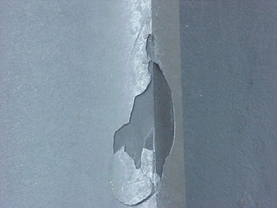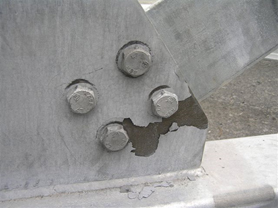Flaking on I-Beams and Edges
Why is the coating coming off in big chunks in the center of the I-beams and the edges of pole baseplates?
The issue with the coatings on these types of steel parts is the thickness of the coating. I-beams and baseplates over 5/8 thick often contain silicon levels in the range of 0.28 to 0.35, making them highly reactive steel. These high silicon levels plus long times in the galvanizing kettle make it likely that the coating is going to be very thick. Typically beams and plates with steel over 5/8 have coating thicknesses above 10 mils (250 microns). While this may be great for corrosion protection, there is a potential problem lurking below the surface with these thick coatings.

A normal thickness galvanized coating, 4.0 to 6.0 mils, will follow the contraction of the steel part as it cools down from galvanizing temperature to ambient temperature. On the other hand, a thick galvanizing coating, over 8.0 mils, will contract more quickly than the steel part causing a significant residual stress in the coating. This stress will gather at the interface between the delta and the gamma layers of the coating. By itself, this stress will not cause the coating to be damaged. Any outside stress on the coated steel part in addition to the residual stress in the coating will combine to cause the coating to fracture in the interface region between the delta and the gamma layers of the coating. The outside stress can come from dropping the steel part onto the ground or a truck bed, or flexing the beam through handling on forklifts, or maneuvering the piece on the job site to fit into a specific location. The coating is most likely to flake off edges or near holes since these areas can be the sites of outside stresses from forklifts or from bolt installation.

In the picture of the I-beam, the fractured coating comes off the steel in wafer pieces leaving only the gamma layer on the steel. Leaving only the gamma layer gives an easily measured indication the coating issue is flaking rather than some other coating issue. The measurement of the coating thickness in the area where the coating flaked off the steel will give readings of 0.1 or 0.2 mils, the thickness of the gamma layer. This indicates that the coating flaked off the steel.

In the case of small areas of the flaking coating, the areas can be repaired using the techniques in ASTM A780. In the case of large areas of the coating flaking off the part will need to be stripped and re-galvanized. Due to the high silicon level in the part, the best plan may be to remove the zinc by shot or grit blasting. This will remove the zinc and leave a rough surface that can lead to lower coating thickness and minimize the chance of a flaking coating.
© 2025 American Galvanizers Association. The material provided herein has been developed to provide accurate and authoritative information about after-fabrication hot-dip galvanized steel. This material provides general information only and is not intended as a substitute for competent professional examination and verification as to suitability and applicability. The information provided herein is not intended as a representation or warranty on the part of the AGA. Anyone making use of this information assumes all liability arising from such use.

